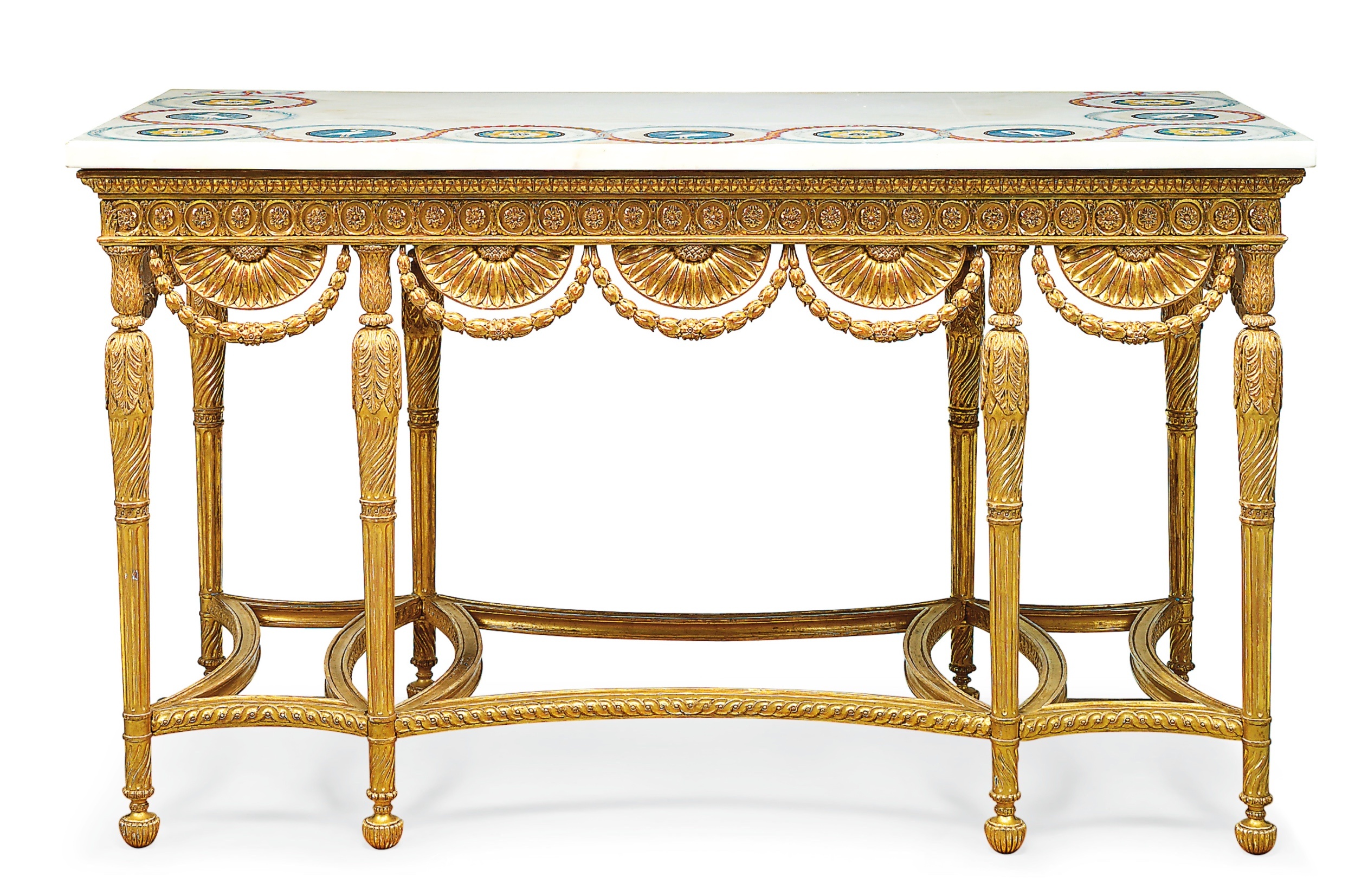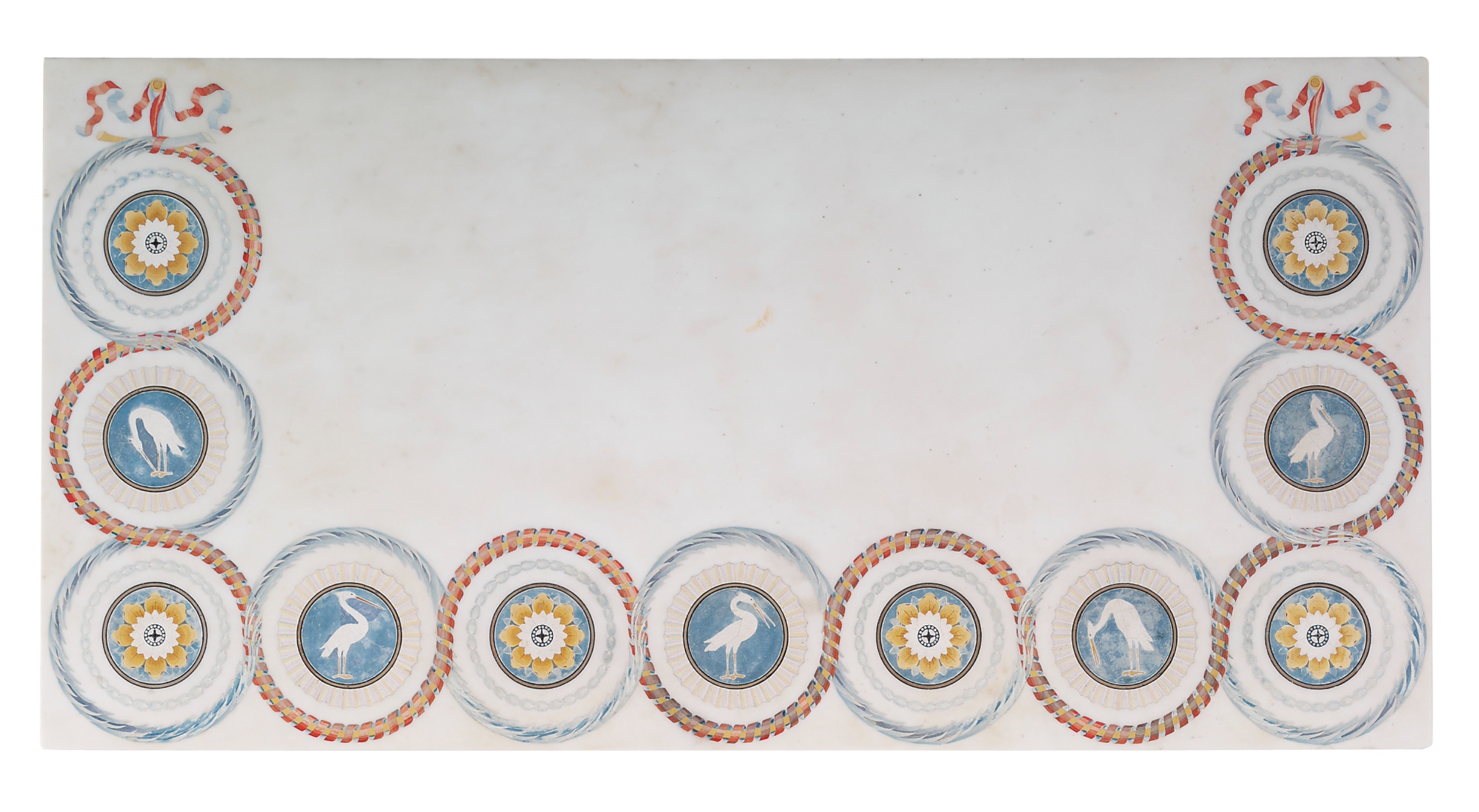

1765 - 1770


Each rectangular white marble top with a band of alternating flowerhead and crane roundels within entwined ribbon-and-leaf borders all hung from tied ribbons, with flowerhead-filled chain frieze above a half-flowerhead and laurel swag apron, replaced following the original design, on carved turned tapering part-spirally-fluted, part-fluted and acanthus-carved legs headed by tulip capitals, joined by concave-sided guilloche-carved stretchers and on spirally-fluted and reeded bun feet, re-gilt,
Supplied in 1770 to Robert Child, Esq. (1739-82), for the first floor front Drawing Room of 38 Berkeley Square and by descent to his grand-daughter Lady Sarah Sophia Fane (1785-1867), wife of George Child-Villiers, 5th Earl of Jersey (1773-1859) and by descent, having moved to Middleton Park, Oxfordshire from 38 Berkeley Square circa 1806-7. George Francis Child-Villiers, 9th Earl of Jersey (1910-98), Middleton Park, Bicester, sold Hampton and Sons house sale, 28 May-1 June 1934, lots 239 and 240. Mrs. Audrey Pleydell-Bouverie (d. 1968; sister of Edward James), Julians Park, Hertfordshire; thence by descent to Capt. J. James.
Earl of Jersey Archive, London Metropolitan Archive (ACC 3752/10/302), John McLean's bill for moving furniture from Berkeley Square to Middleton Park in 1806-07. 1867 Probate Inventory of Middleton Park (following the death of Lady Sarah Sophia Fane, wife of the 5th Earl of Jersey), in The Dining Room as 'Two gilt table stands with marble tops and inlaid with scagliola'. C. Hussey, 'Julians, Herfordshire - II, The Home of the Hon. Mrs. P. Pleydell-Bouverie', Country Life, 27 June 1947, pp. 1210 & 1212, fig. 2 (showing the tables in the Entrance Hall, without any frieze carving and with ebonised and parcel-gilt decoration). Christie's International Magazine, May/June 2001, p. 112 (showing one of the tables in situ in the dining room at Middleton Park, circa 1910).
This table pattern, with paired sideboard-fashion legs, was invented by Robert Adam (d. 1792) in 1770 for Robert Child's Berkeley Square house. The design for the tables and their accompanying pier-glasses is inscribed 'Glass frame for front Drawings Room and one pair stairs at Mr Childs in Berkeley Sqr'. The design is now in the Victoria and Albert Museum (A. Rowan, Robert Adam, 1988, no. 63) and is illustrated in P. Ward-Jackson, English Furniture Designs, London, 1958, fig. 210. Evoking Apollo's triumph on Mount Parnassus, its frieze is festooned with laurel-wreathed half-sunflowers tied by a flowered ribbon-guilloche, while palms flower its strigil-fluted and antique-fluted columnar legs. Robert Child had purchased 38 Berkeley Square from the Earl of Manchester in 1767. Robert Adam's drawings for the interiors as well as for several pieces of furniture exist; however, besides the present tables, the ceiling in the front drawing room and some doors, it is not known how many of the designs featured in the drawings were executed. The ceiling was transferred to Hinton Ampner House in Hampshire, shortly before the destruction of 38 Berkeley Square and some doors are now at Buxted Park, Sussex. In order to deprive the Fane descendants of his son-in-law John Fane, 10th Earl of Westmoreland (1759-1841), who had eloped with his daughter Sarah Anne Child (1764-93), Robert Child settled his property, including Middleton Park, Oxfordshire on his granddaughter, Lady Sarah Sophia Fane, who married the Earl of Jersey in 1804. Thus Middleton passed to the Earls of Jersey, although Sarah Sophia, Lady Jersey, who died in 1867, had retained it after her husband's death in 1859. The inventory of Middleton taken after her death in 1867, records in the Dining-Room: 'Two gilt table stands with marble tops and inlaid with scagliola'. The tables were moved to Middleton shortly after her marriage when she and Lord Jersey renovated Middleton and moved much of the furniture at the Berkeley Square house there. They employed the cabinet-makers and upholders John McLean & Son to renovate the house, including supplying new furniture and repairing furniture already in their possession. A manuscript account covering the period from July 1806 to April 1807, presented by the firm of John McLean & Son, totals £4,793. 11s. 10d. The bill demonstrates that much of the furniture from Berkeley Square was crated and carried to Middleton (Simon Redburn, 'John McLean & Son', Furniture History, vol. XIV, 1978, pp. 35-7). The bill makes specific reference to a pair of tables which are undoubtedly the present pair: To a 3/4 skeleton case for packing Gilt Pier table frame and round Library table pillar, containing 74ft @ 4d...£1 4s 8d ... To a 3/4 skeleton Case for Gilt Pier Table frame 74ft @ 4d...£1 4s 8d ... Two 3/4 Close Cases for 2 inlaid marble slabs 68ft @ 6d...£1 16s 10d (Earl of Jersey Archive, London Metropolitan Archive (ACC 3752/10/302)). McLean was also employed to repair various pieces of furniture at Middleton, and one entry for the Dining Room notes that he repaired 'a pair of large elegant carved Pier Tables in burnish'd gold' - almost certainly the present tables (Redburn, op. cit., p. 36). It is possible that the original sunflower and swag ornament of Adam's design - now faithfully replaced - was damaged or lost by the time of these repairs. The colour scheme for the room was red with a 'turkey pattern floor cloth', and McLean supplied new furniture in the Regency Style including 'An elegant Mahny. Sideboard bronze figures and antique Pedestals' and 'An Egyptian Sarcofacus on Lions heads feet to correspond' (ibid.). That the 'pair of large elegant Pier tables' are in such contrast to the other new furniture and were repaired rather than supplied is further indication that they were already in the possession of the Earl and Countess of Jersey. The tables (and the McLean sideboard) are visible in the dining room at Middleton in a photograph of circa 1910 (having lost their distinctive sunflower apron ornament, which has since been replaced). In 1934, the contents of Middleton Park were sold by Hampton and Sons, and the house demolished to make way for Sir Edwin Lutyens's last great country house. They were almost certainly bought at the Middleton sale by Mrs. Audrey Pleydell-Bouverie (d. 1968), daughter of William Dodge James (d. 1907) and older sister of Edward James (1902-84) of West Dean, Sussex. Mrs. Pleydell-Bouverie installed them six years later in her new house, Julians Park, Hertfordshire. The marble tops can be attributed to John (Johan) August Richter (fl. 1767-1796), who, with Domenico and Giuseppe Bartoli (fl. 1765-1794), was among the leading scagliola-makers of the period. Richter and the Bartolis established their Great Newport Street partnership in 1766. The present tops can only have been made within the very narrow period 1765-70 - in 1765 Bartoli produced his first inlay on white marble at Burton Constable and by 1770 Robert Adam drew the first designs for a D-shaped top - after which all English and Irish scagliola tables were D-shaped. Richter patented his invention of inlaying scagliola in 1770, interestingly with specific mention to birds, however he was inferior to Bartoli in both design and execution. A comparison of the present tops and Bartoli's Burton Constable tops clarifies this attribution: the cranes/storks here are less defined than the rattlesnakes featured in Bartoli's work, and the borders here are fairly large and close to the edge of the marble itself. Nevertheless Richter was the only non-Italian to achieve any sort of competence in the art of scagliola inlay, and his work is rare. Robert Adam's design for Robert Child may also have formed the basis of a pair of pier tables executed circa 1775 by John Linnell (d. 1796) for William Drake at Shardeloes, Buckinghamshire, who was a valued client of both William (d. 1763) and John Linnell for some 25 years. The tables were created as part of a modernisation scheme commenced in 1758, with the drawing room for which they were eventually supplied the last room to be completed. Linnell had originally prepared alternative designs for the tables and pier glasses to be supplied en suite, however the end products were much closer to Adam's design; they are now in the Rijksmuseum, Amsterdam. Other Adam designs executed by Linnell for Shardeloes include a pair of ormolu-mounted sideboard urns and pedestals for the same room, sold Christie's London, 27 November 2003, lot 88 (£240,450). Interestingly the urns were invoiced by Linnell as direct copies of versions he had already supplied to Robert Child (after designs by Adam) for Osterley, on the 2nd October 1767 as : 'To making and carving 2 coopers the tops in the form of vases and large brass handles like Mr Childs'. The shape, frieze pattern and stretchers of the present tables correspond to a further design by Robert Adam dated 1767 for a pair of magnificent tables for the Great Room at Coventry House, Piccadilly, for the 6th Earl of Coventry, supplied in 1768 by Sefferin Alken at a cost of £212.6.11. The only substantial differences between the design for these tables and the Coventry tables are that the latter design has a more unconventional block-headed leg pattern and features garland-hung urns on circular trays between the stretchers. The Coventry tables feature 'Mosaic' scagliola tops made by Richter and Bartoli to Adam's design at a cost of £65 each.
| Dimensions | CM | Inches |
|---|---|---|
| Width: | 150 | 59 |
| Depth: | 74 | 29 |
| Height: | 87 | 34 |